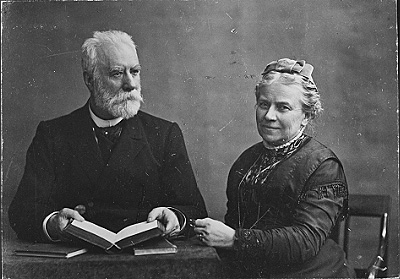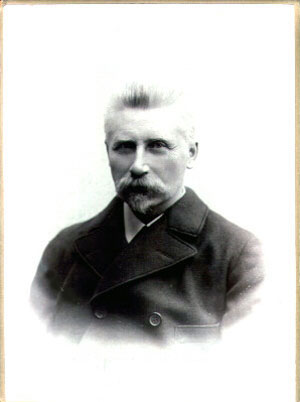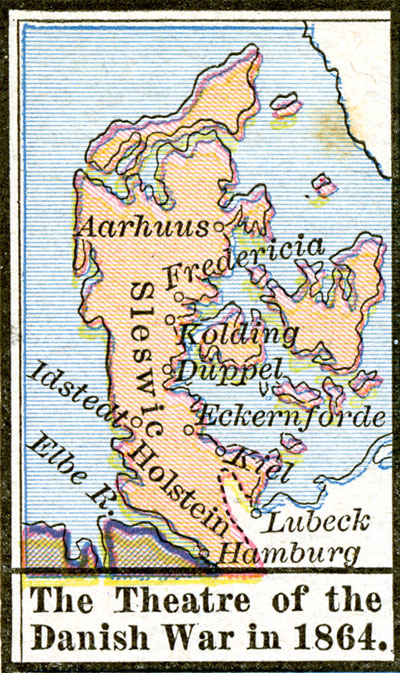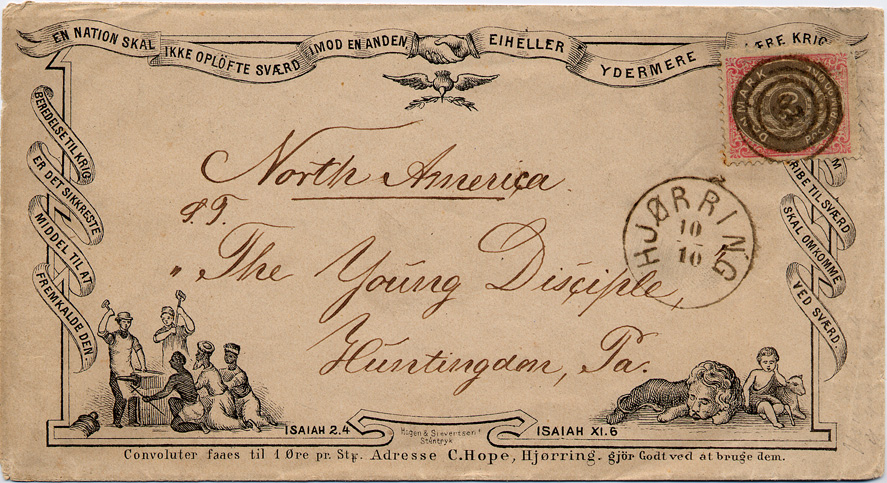The Danish Peace Academy
Holger Terp: Danish Peace History
Working paper 1
Liberal political antimilitarism 1849-1914
 |
|
Source: Kvindehistorisk Samling, Statsbiblioteket. |
 |

|
The political debate over the defence and security policy of Denmark began before and during the discussions over the new constitution in 1849.
This long and heated debate resulted in the creation of a radical political culture, who succeeded in the nearly complete disarmament of Denmark after World War One.
As early as in May 1836, counsellor of justice and land owner Malte Bruun Nyegaard (1789-1877), in the Viborg Assembly of the Estates of the Realm73, argued against general conscription and a rise in military expenditures, “Because of the coming rule of reason, wars will become rare, and the best projection for the country is the diplomacy”. Expensive Danish armament would “not benefit against the great powers”74.
Later prime minister, bishop D. G. Monrad (1811-1887) concluded the debate as being “about political dreaming”, when nationalists wanted a strong defence75. Monrad immigrated to New Zealand.
During this debate the first liberal party the Society of Friends of the farmers, was created76, with the pacifist teacher and politician Lars Bjørnbak (1826-1878) as one of the leaders. In 1870 the Christian Lars Bjørnbak was the author of the first pacific protest to the parliament. Bjørnbak was active in the Danish Folk High School movement.
Journalist, publisher and liberal politician Viggo Hørup (1841-1902) is unknown outside Scandinavia, though he was the most important Danish anti-militarist politician in the last part of the 19th. century, when Denmark 1849 to 1894 was a militarised police state.
Viggo Hørup introduced the concept militarism in the debate over the fortification of Copenhagen and asked the simple but powerful question in the parliament: What should it [the military] benefit? As a part in the political struggle between the nationalists and the liberals, Hørup and journalist Edvard Brandes (1847-1934) founded the newspaper Politiken 1884 of which Hørup became the chief editor. The liberals founded many newspapers to conquer the public opinion.
Viggo Hørup was the father of Ellen Hørup, herself a pacifist journalist. Most Danish biographies about Viggo Hørup are written by politicians, and only a couple by historians77.
The liberal politican Fredrik Bajer (1837-1922) published his memories in 1909. This covers the period up to 1908. As one of the few Danes in international organised peace work he was awarded with a half Nobel peace prize in 190878. Bajer was a founding member of the Inter-Parliamentary Union79, The International Peace Bureau80 and the Danish Peace Society81, a Danish biography covering the period from 1908 to 1922 is much needed and an English biography might highlight Danish peace work82.
His wife Mathilde (1840-1934) is nearly forgotten today, even though she worked in international women peace groups in her own right83, she were vice-president in Alliance universelle des femmes pour la paix. Also the couple established the first women rights organisation in Denmark. A biography of Mathilde Bajer might be needed. Also useful might be bibliographies on both Bajer’s84.
Though members of the same political party Bajer and Hørup didn’t get along well. The rich Hørup wanted to conquer the political power in the parliament, while the poor Bajer was working as a grassroot.
The Danish Peace Union worked in the beginning for Danish neutrallity with the hope that this policy could regain the in the 1864 war lost territories to Denmark. Within a couple of year the union changed tactic and added arbitration as it's main focus.
Browsing through the justice ministry’s files in the Record Office revealed, that this ministry was in charge of the general conscription in the period 1851 to 1914; when conscription was taken over by the Ministry of the Interior, until the administrator of conscription in February 2004 was taken over by the Ministry of Defence.85
The war of 1864 |
Danes used civil disobedience86, desertion and were conscientious objectors during the 1864 war with Germany-Austria. In the period 1863-65 the moulder Ove Petersen was sentenced four times for objection based on religious conviction. The military court used the same argumentation as in the case of Könecken: “because of religious fanaticism objected to dress in the uniform and conscription”, and because of religious fanaticism objected “duty” and “deserted”87. This is but one of many cases during and after the war.
Some Danish prisoners of war were returned to Denmark years after the war. Their German prison experience made them insane88. This subject is unknown to military historians and needs more research. One of Fredrik Bajer's booklets on the diplomatic negotiations after the war in 1864, "A serious drama of modern history : how Danish Slesvig was lost : a peep behind the veiled scenes of diplomacy, and a warning", was translated by P. H. Peckover and published by the London Peace Society.
In his book Bajer documents that it was not the Danish military that lost the war in the winter and spring of 1864. The war was lost by the diplomats who would not give in to the stronger foes, because of popular support to the war from the big landowners, the politicians and ordinary people. Concluding Bajer lamented that the Danish militarism which boasted that it could get a military victory over Prussia and Austria only was so strong because there were too few pacifists in the state of Denmark, but hope there was for the future. In the might and glory of the militant, romantic nationalism the first small voice of pacifism came from the Friends of the Farmers.
The lost war of 1864 became a important subject in the continued Danish security debate.
German military service was enforced upon the conquered Danes of South Jutland who only had one legal option to escape: immigration. By 1870 nearly all conscripted Danes in the so called optant movement, emigrated89. It is not known how many Danes immigrated to the United States, Canada and Australia because of military conscription in the years 1849 to 191790. However the study of historian Peter Mikael Hansen suggest a connection with the abstention from the draft and the Danish immigration in the period 1880 to 191491.
Also during World War One more than 2.400 Southern Jutlander’s with Danish sympathies deserted from the German colours by escaping to Denmark92.


The Christian Peace Union, Kristeligt Fredsforbund, was created in the spring of 1913 as the third Danish peace group. Its now rare magazine “Fredsvarden”, named after the German magazine “die Freidens-Warte” / the “Peae Observation Tower” is an invaluable source of information about Danish and international Christian peace work from 1913 to 1940. Today there is only one complete set of “Fredsvarden” in the State Library in Aarhus. After World War One the Christian Peace Union became a member of the International Fellowship of Reconciliation. The Danish Christian Peace Union’s history needs to be written.

Notes |
73 Viborg Stænderforsamling.
74 Thomsen, Rudi: Den almindelige værnepligts gennembrud i Danmark, 1949. p. 48.
75 Regarding Monrad See: Oldenburg, F.: Biskop Monrad og den politiske Partikamp. – Lehmann & Stage, 1882. – 94 pp.
76 Bondevennernes Selskab.
Det radikale Venstres Historie / edited by Gunnar Fog-Petersen. Odense : Kulturhistorisk Forlag, 1938.
77 Arup, Erik: Viggo Hørup, 1941. Hørup i breve og digte : Breve, digte og litterære prosastykker til belysning af Viggo Hørup og hans kreds / publisher Karsten Thorborg, 1981. Krog, Torben : Viggo Hørup, 1984.
78 Nobels Fredspris : Hundre år for fred : Prisvinnere 1901-2000 / Øivind Stenersen ; Ivar Libæk ; Asle Sveen. Oslo, 2001.
79 Zarjevski, Yefime: The people have the floor : A History of the Inter-parliamentary Union. Dartmouth. 1989. See also vol. 2 of Alfred H. Fried’s: Handbuch der Friedensbewegung. Berlin, 1913 ; 1972.
80 Allen, Devere: The Fight for Peace. New York, 1930 ; 1971 p. 473.
81 Risskov Sørensen, Kurt: Fredssagen i Danmark 1882-1914, 1981 See also the volume of Sune Pedersen. In 1971 the Danish Peace Society became a part of the Danish United Nations Union, FN-forbundet.
82 § 3.Le mouvement de la paix organisé. In: Augsut Schou: Histoire de l’ internationalisme III. Oslo: MCMLXIII pp. 510-516
83 Rimmen Nielsen, Hanne: Bertha von Suttner i København 1906 : Et billede i Kvindehistorisk Samling. In: Rotunden, no. 16, 2001 pp. [4]-23.
84 Fredrik Bajer Bibliography.
Politikeren Fredrik Bajer (†1922) og hustrus [Mathilde Bajer] arkiv. 1963. - 28 pp. ; Foreløbige arkivregistraturer. Serie 8).
85 Petersen, Niels: Justitsministeriet : Organisation og arkiv, 1982.
86 Bajer, Fredrik: Livserindringer. 1909 p.
120.
Map source: Robert H. Labberton, New Historical Atlas and General
History (New York, NY: Townsend MacCoun, 1886)
Map Credit: Courtesy The Private Collection of Roy Winkelman
http://etc.usf.edu/maps/pages/6900/6926/6926.htm
87 Hansen, Peter Mikael: Militærvægring 1849-1917. Roskilde 2001 pp. 69-70.
88 Politiefterretninger. Danmark. In: Adresseavisen, Kristiania [Oslo], 1869, No. 8 p. [3].
89 Indførelse af preussisk Værnepligt og Administration. In: Schultz History of Denmark / Danmarkshistorie, Vol. 5 pp. 94-96.
90 Hvidt, Christian: Flugten til Amerika.
Århus, 1971.
Australia: See: Sjøquist, Sigurd: Danish Church
Australia
http://danishchurch.org.au/showpage.asp?id=331574964
91 Hansen, Peter Mikael: Militærvægring 1849-1917 pp. 60 and 83.
92 Falkner Sørensen, Svend: Faneflugt? Dansksindede soldaters flugt fra tysk krigstjeneste 1914-1918. - Aabenraa : Historisk samfund for Sønderjylland, 1989 p. 25.
|
|
|